Deposition behaviour of FeCrMnNiCo coatings deposited using mechanically alloyed powder: Comparing Cold Spray, HVOF, HVAF, and Laser Cladding processes
IF 5.3
2区 材料科学
Q1 MATERIALS SCIENCE, COATINGS & FILMS
引用次数: 0
Abstract
This study examined the characteristics of mechanically alloyed (MA) Cantor alloy powder and the coatings produced from it using various deposition techniques, including cold spray (CS), high-velocity oxy-fuel, high-velocity air-fuel, and laser cladding (LC). Microstructure analysis of the MA powder revealed an irregular morphology and incomplete elemental mixing. The microstructure of the CS coating displayed an FCC crystal structure, with some XRD peaks corresponding to BCC phases due to the presence of unmixed elements. In contrast, all other coatings also exhibited oxides alongside FCC and BCC phases, with the LC coating containing a higher concentration of oxides. These coatings demonstrated high density and diverse microstructures, with CS coatings demonstrating effective transfer of powder microstructure. The CS coating had the highest hardness (679 ± 17 HV0.1) due to the retention of deformed microstructure from the powder, whilst the LC coating had the lowest hardness (215 ± 10 HV0.1). CALPHAD calculations using Thermo-Calc suggest that the presence of oxides in the coatings could be thermodynamically feasible, depending on the conditions. Deposition efficiency varied significantly among the methods, with LC achieving the highest efficiency (63 ± 6 %) and CS the lowest (14 ± 1 %).

使用机械合金粉末沉积的铁铬镍钴涂层的沉积特性:冷喷、HVOF、HVAF 和激光熔覆工艺比较
本研究考察了机械合金(MA)康托合金粉的特性,以及利用冷喷(CS)、高速纯氧燃料、高速空气燃料和激光熔覆(LC)等各种沉积技术生产的涂层。对 MA 粉末的微观结构分析表明,其形态不规则,元素混合不完全。CS 涂层的微观结构显示出 FCC 晶体结构,由于存在未混合的元素,一些 XRD 峰对应于 BCC 相。相比之下,所有其他涂层在显示 FCC 和 BCC 相的同时也显示出氧化物,其中 LC 涂层含有更高浓度的氧化物。这些涂层显示出高密度和多样化的微观结构,其中 CS 涂层显示出粉末微观结构的有效转移。由于保留了粉末的变形微观结构,CS 涂层的硬度最高(679 ± 17 HV0.1),而 LC 涂层的硬度最低(215 ± 10 HV0.1)。使用 Thermo-Calc 进行的 CALPHAD 计算表明,涂层中存在氧化物在热力学上是可行的,这取决于条件。各种方法的沉积效率差异很大,LC 的效率最高(63 ± 6 %),CS 的效率最低(14 ± 1 %)。
本文章由计算机程序翻译,如有差异,请以英文原文为准。
求助全文
约1分钟内获得全文
求助全文
来源期刊

Surface & Coatings Technology
工程技术-材料科学:膜
CiteScore
10.00
自引率
11.10%
发文量
921
审稿时长
19 days
期刊介绍:
Surface and Coatings Technology is an international archival journal publishing scientific papers on significant developments in surface and interface engineering to modify and improve the surface properties of materials for protection in demanding contact conditions or aggressive environments, or for enhanced functional performance. Contributions range from original scientific articles concerned with fundamental and applied aspects of research or direct applications of metallic, inorganic, organic and composite coatings, to invited reviews of current technology in specific areas. Papers submitted to this journal are expected to be in line with the following aspects in processes, and properties/performance:
A. Processes: Physical and chemical vapour deposition techniques, thermal and plasma spraying, surface modification by directed energy techniques such as ion, electron and laser beams, thermo-chemical treatment, wet chemical and electrochemical processes such as plating, sol-gel coating, anodization, plasma electrolytic oxidation, etc., but excluding painting.
B. Properties/performance: friction performance, wear resistance (e.g., abrasion, erosion, fretting, etc), corrosion and oxidation resistance, thermal protection, diffusion resistance, hydrophilicity/hydrophobicity, and properties relevant to smart materials behaviour and enhanced multifunctional performance for environmental, energy and medical applications, but excluding device aspects.
 求助内容:
求助内容: 应助结果提醒方式:
应助结果提醒方式:


